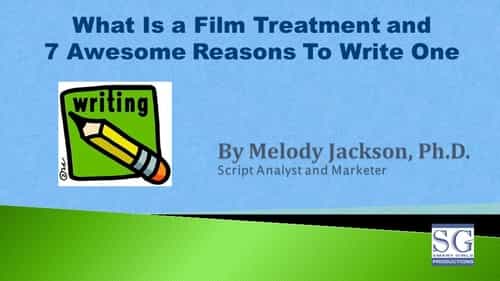 So many ideas…. so little time to write whole screenplays. It’s far easier to write a film treatment than an entire screenplay since it’s only a few pages… but what is a film treatment?
So many ideas…. so little time to write whole screenplays. It’s far easier to write a film treatment than an entire screenplay since it’s only a few pages… but what is a film treatment?
A film treatment is essentially a 3 to 5 page version of your story written in a regular prose format. In a nutshell, the fact it’s only a few pages is why it’s a great idea to write a treatment for your movie ideas, but there are several other great reasons to do so which I will cover in this article.
Most screenwriters, both aspiring and professional, have so many story ideas that there is no way they can write them all as screenplays…. but you could take on writing many more as treatments.
If you’re working a full-time job and it’s not screenwriting, you’ll be lucky to complete two screenplays a year or even three every two years. It’s simply not realistic to do many more than that in your spare time and develop them to be strong, well-structured stories with interesting characters.
The question is, what’s a writer to do when you have so many great story ideas that you want to write but don’t have enough time?
To give you an answer, I’d like to borrow a line from a scene in the film The Graduate. Mr. McGuire told Benjamin [Dustin Hoffman], “I’ve got one word for you…” His word for Benjamin was “plastics.” My one word for you as a screenwriter: “Treatments.” Writing treatments is how you can optimize your writing time if you have more great ideas than time to write screenplays for.
A treatment is a 3 to 5 page narrative of your story. Essentially, it’s like writing a short story with only the important things in it.
Let’s look at Seven Reasons writing a treatment first is a brilliant practice to put in place instead of just jumping into writing your screenplay.
- Writing a treatment helps you develop the broad strokes of your plot, characters, structure and theme before you get down into the weeds of individual lines of dialogue.
Since a treatment is so much shorter than a screenplay, you have to really think through what the main aspects are of plot, characters, structure and theme so you can fit it into just a few pages.
- When you start with a treatment for your movie, you can figure out if you can make the overall story work in a much shorter time.
When you write a treatment and really work on the key elements mentioned above, you may find that you can’t make the story work as you had planned. If you have to make a major plot or character change, it is far easier to do in a treatment than in a 100-page script.
It’s also easier (and cheaper) to have a treatment evaluated and then go rewrite 3 to 5 pages a few times than it is to have your screenplay evaluated and have to re-write 100 pages multiple times.
- A treatment will help you be far more focused on writing scenes that will stay in the script.
By writing a treatment, you will save yourself time on writing individual scenes that may not fit in the big picture. When you jump straight into writing the screenplay, you will inevitably writes scenes that you’ll end up deleting.
Even with a treatment, you will likely still remove some scenes or portions of scenes along the way, but it will be far fewer than if you write without a treatment.
Benefits of Writing Treatments in Marketing Your Screenplay
We’ve now looked at the benefits of how treatments help you in the craft of screenwriting, and there’s another set of benefits of writing treatments for your movie scripts as it relates to marketing. Let’s take a look at those.
- Having multiple treatments ready will help you maximize your marketing efforts.
If you’ve ever tried to sell your screenplays, then you’ve certainly been told “no, not for us.” If you were in close enough proximity to the reader at that point, they may have asked you if you had anything else. If you’re like most writers, you probably had another script or two or three, but it’s likely that they were “not ready.” Or maybe you couldn’t decide which would be the best to offer the producer/agent/reader.
Now imagine if you had a treatment for each of your scripts or even for stories that you hadn’t yet written the script for, you could offer them multiple options right there in the moment.
Even better, if someone reads your script and they don’t ask you for anything else, you could offer them a couple of treatments on stories that may be of more interest to them. It would be far less an investment of their time to read another treatment than another screenplay. But you can only do that if you have those treatments to offer.
- It’s much easier and faster to polish a treatment before sending it to them than it would be to polish a 100-page script.
For that matter, if they agreed to see something else from you, you could write a treatment from scratch in one night on an unfinished script you’ve been working on and send it to the reader the next day. You could then get feedback on whether the idea is worth spending the next one to five years on writing it as a screenplay.
- You’ll also be more motivated about your screenwriting since it’s much easier and more fun to work on multiple stories when you’re writing treatments.
Sometimes working on a different script will even help your creativity. Switching between stories can give you fresh eyes on the one you’ve been working on tirelessly. Not to mention it will add to the fun and create more product for you.
- You’ll be able to test your ideas much more quickly to see if there’s interest.
You could spend years on writing and polishing an entire screenplay only to find out it’s not marketable material. If you write a treatment first, you can test out your ideas in a much shorter learning curve compared to writing the entire screenplay.
One final thing in case this is you…. Some screenwriters don’t like to write treatments because they say they see a scene in their head and want to get it on the page. Other writers think writing scenes is simply more fun. So what do you do about that?
Simple answer: You work on the treatment and simultaneously write some of your scenes in your script writing software as you see fit. This way you get the benefit of focusing on developing your structure but also have fun writing some of the scenes and dialogue.
By now I’m hoping I’ve sold you on the value of writing a treatment. If you need to know how, go to my article how to write a film treatment for your screenplay.
In summary, getting really good at writing treatments will help you more effectively select which are your best ideas to write as a screenplay. You’ll be far more efficient with your time. And you’ll be able to better maximize your marketing efforts by having a fuller slate to offer prospective producers or agents.
If you are serious about selling a screenplay or having a screenwriting career, you can’t afford to spend time writing a screenplay that has inherent, unfixable issues.
Consider how many more treatments you could write than screenplays. You could probably develop 4 or 5 treatments in the same amount of time it would take you to write an entire screenplay.
Imagine you write 2 or 3 or 4 or 5. You could then have them evaluated to help you pick the best one to write. Or if you know for sure you want to write a given story as a screenplay, simply shortcut your development time by writing the treatment, getting that evaluated and developed. Then you have a real blueprint for a great screenplay.
There are many reasons to take on learning how to write treatments, not to mention the fact that it helps you develop your basic story-telling craft.
If you like this idea and you want feedback on your treatment or screenplay, check out our script analysis services — one of them is a review of a treatment. We would love to help.

